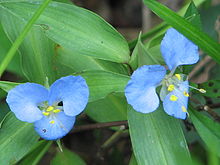- Commelina virginica
-
Commelina virginica Specimen at the Congaree National Park in South Carolina, USA Conservation status Scientific classification Kingdom: Plantae (unranked): Angiosperms (unranked): Monocots (unranked): Commelinids Order: Commelinales Family: Commelinaceae Subfamily: Commelinoideae Tribe: Commelineae Genus: Commelina Species: C. virginica Binomial name Commelina virginica
L.Commelina virginica, commonly known as the Virginia dayflower, is a perennial herbaceous plant in the dayflower family. It is native to the mideastern and southeastern United States, where it is typical of wet soils. While most members of the genus have thin, fibrous roots, the Virginia dayflower is relatively unique for its genus in having a perennial rhizome. The plant was first described by Carolus Linnaeus in his 1762 publication of the second edition of Species Plantarum.[2]
References
- ^ "Commelina virginica". NatureServe Explorer. NatureServe. http://www.natureserve.org/explorer/servlet/NatureServe?searchName=Commelina+virginica+. Retrieved 2008-08-25.
- ^ Faden, Robert (2006). "Commelina virginica". In Flora of North America Editorial Committee, eds. 1993+. Flora of North America online. 22. New York & Oxford: Oxford University Press. http://www.efloras.org/florataxon.aspx?flora_id=1&taxon_id=222000046. Retrieved 2008-08-25
External links
 Media related to Commelina virginica at Wikimedia Commons
Media related to Commelina virginica at Wikimedia Commons- Profile at Flora of Missouri Webpage
- Profile at USDA PLANTS Database

This Commelinales-related article is a stub. You can help Wikipedia by expanding it.


